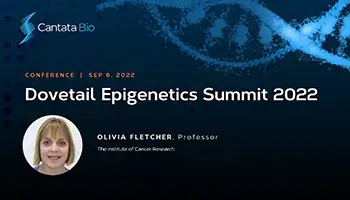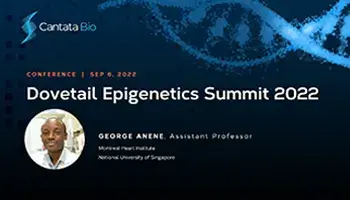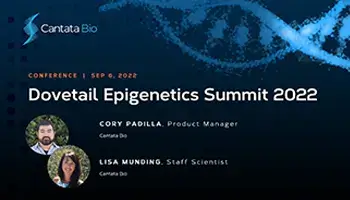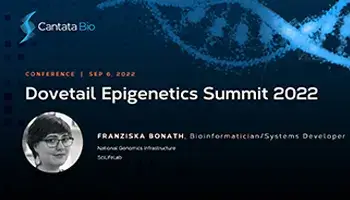Todd Dickinson
Cantata Bio, CEO
Welcome to the Dovetail Epigenetics Summit 2022! Learn how Cantata Bio, the new company formed bringing Dovetail Genomics and ArcBio together, helps you see things you couldn’t see before!
Olivia Fletcher, Professor of Functional Genetic Epidemiology
The Institute of Cancer Research
Genome-wide association studies (GWAS) coupled with large-scale replication and fine-scale mapping studies have led to the identification of more than 150 genomic regions that are associated with breast cancer risk1. Efforts to translate these findings into a greater understanding of the mechanisms that influence a woman’s risk of breast cancer, require the identification of functional variants and the targets of these functional variants. The vast majority of GWAS signals map to non-protein-coding regions and are thought to influence transcriptional regulation. To generate the high-resolution data required for cataloguing interaction peaks at kilobase (or less) resolution, we developed region-capture Hi-C (rCHi-C) and used this methodology to identify target genes at three breast cancer-associated gene deserts2. We and others have expanded this approach to identify putative target genes at up to 139 independent breast cancer signals3, 4. To date all of these studies have used HindIII digestion of chromatin and, given that breast cancers arise in cells of epithelial origin, they have focussed on breast cancer or “normal” immortalised breast epithelial cell lines for library generation. It is well established, however, that cancer progression and metastasis does not depend solely on cancer cell-autonomous defects and that the stroma, of which fibroblasts comprise a dominant component, has a functional role5. To refine the selection of putative target genes and credible causal variants (CCVs) at breast cancer risk loci we used the Dovetail® Omni-C® protocol and a combination of promoter CHi-C (pCHi-C) and rCHi-C approaches. To investigate whether a subset of genes might act in a non cell-autonomous manner we included immortalised mammary fibroblasts in our analysis.
- Fachal L, Aschard H, Beesley J, Barnes DR, Allen J, Kar S et al. Fine-mapping of150 breast cancer risk regions identifies 191 likely target genes. Nat Genet 2020; 52(1): 56-73;
- Dryden NH, Broome LR, Dudbridge F, Johnson N, Orr N, Schoenfelder S et al. Unbiased analysis of potential targets of breast cancer susceptibility loci by Capture Hi-C. Genome research 2014; 24(11): 1854-1868;
- Baxter JS, Leavy OC, Dryden NH, Maguire S, Johnson N, Fedele V et al. Capture Hi-C identifies putative target genes at 33 breast cancer risk loci. Nature communications 2018; 9(1): 1028;
- Beesley J, Sivakumaran H, Moradi Marjaneh M, Lima LG, Hillman KM, Kaufmann S et al. Chromatin interactome mapping at 139 independent breast cancer risk signals. Genome Biol 2020; 21(1): 8;
- Kalluri R. The biology and function of fibroblasts in cancer. Nat Rev Cancer 2016; 16(9): 582-598; e-pub ahead of print 2016/08/24;
Payel Sen, Stadtman tenure-track investigator
NIH
Epigenetic alterations are one of the key hallmarks of aging. How epigenetic changes broadly affect euchromatin-heterochromatin balance, three-dimensional chromatin conformation, histone composition and global transcriptome in aging have not been addressed. Using murine liver as a model organ and an integrated multi-omics approach, we find that aged cells assume a repressed chromatin state characterized by a condensed chromatin, broad heterochromatinization, global suppression of the transcriptome and inability to self-interact over long distances. Our findings reveal that global chromatin alterations pose a barrier and promote a cellular state that is refractory to injury sensing and repair.
George Anene, Asst. Professor
Montreal Heart Institute & National University of Singapore
The 3D chromatin architecture establishes a complex network of genes and regulatory elements necessary for transcriptomic regulation in development and disease. This network can be modeled by cis-regulatory hubs (CRH) which underscore the local functional interactions between enhancers and promoter regions and differ from other higher order chromatin structures such as topological associated domains (TAD). The Activity-by-contact (ABC) model of enhancer-promoter regulation has been recently used in the identification of these CRHs, but little is known about the role of CTCF on the ABC scores and the consequent impact on CRHs.
Here we show that the loss of CTCF leads to a reorganization of the enhancer-promoter interactions resulting in a re-distribution of ABC scores of the putative enhancers. The loss of CTCF also leads to a global reduction of the total number of CRHs, and an increase in the size of the CRHs due to increase in the number of elements within each hub. In addition, CTCF loss led to more CRHs that cross TAD boundaries.
These results provide another layer of evidence to support the importance of CTCF in the formation of regulatory networks necessary for gene regulation. Thus, mutations that affect genomic binding of CTCF could impact overall strength of enhancers and dysregulation of genes within a hub.
Cory Padilla, Product Manager & Lisa Munding, Staff Scientist
Cantata Bio
What You’ll Learn:
- How the world of proximity ligation has developed, and the challenges that still remain
- How Cantata Bio aimed to address these challenges with its new Dovetail® TopoLink™ Assay
- How Dovetail® TopoLink™ data enables ATAC-seq and RNA-seq-based researchers to explore distal regulatory element’s role in gene regulation
Franziska Bonath, Bioinformatician/Systems Developer
National Genomics Infrastructure, SciLifeLab
The National Genomics Infrastructure (NGI) is a Sweden-based core facility for sequencing services. Its main goal is to give Swedish academia access to state-of-the-art DNA and RNA sequencing and genotyping technologies. Recently, NGI added protocols to investigate chromosomal structure to its portfolio, which come with unique requirements and challenges. I will talk about the setup process of Hi-C methods at NGI, explaining the considerations and issues that may be specific to core facilities but might also apply to individual projects run locally. Over the past year we assessed products from several vendors and established the Omni-C protocol in our production laboratory, while Micro-C and HiChIP protocols are currently in their pilot phase.
One component of NGI is to aid their users in experimental design, sample handling and sequencing requirements. As such, we need to invest time and resources to acquire the expertise in each protocol offered. Our main service includes the library preparation from flash-frozen, ground tissue samples and cells, library quality assurance and sequencing on Illumina sequencers. On a case-by-case basis we may also perform basic bioinformatic quality control and scaffolding.







